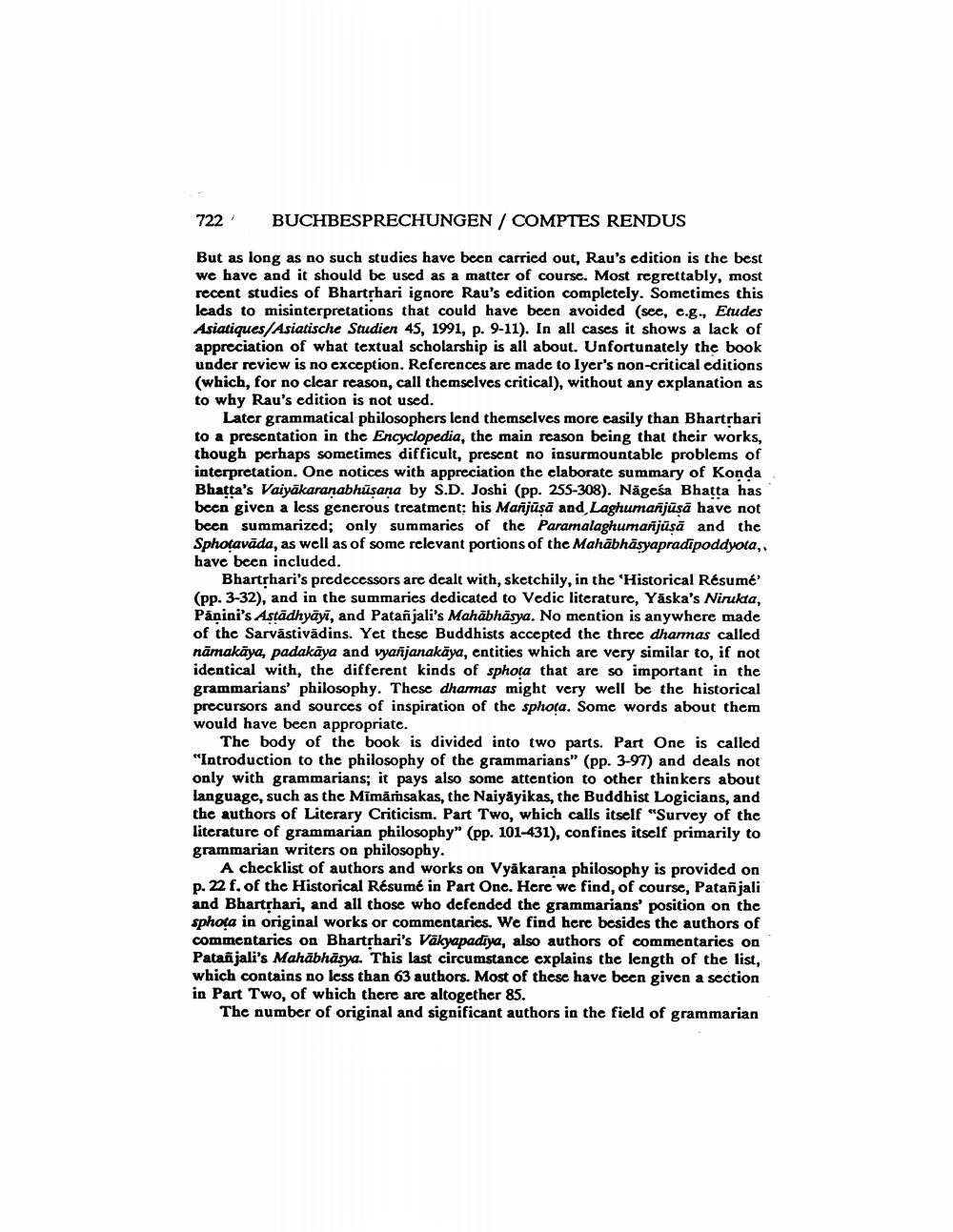Book Title: Book Review Encyclopedia Of Indian Philosophies Author(s): Johannes Bronkhorst Publisher: Johannes Bronkhorst View full book textPage 5
________________ 722 BUCHBESPRECHUNGEN / COMPTES RENDUS But as long as no such studies have been carried out, Rau's edition is the best we have and it should be used as a matter of course. Most regrettably, most recent studies of Bharthari ignore Rau's edition completely. Sometimes this leads to misinterpretations that could have been avoided (see, e.g., Etudes Asiatiques/Asiatische Studien 45, 1991, p. 9-11). In all cases it shows a lack of appreciation of what textual scholarship is all about. Unfortunately the book under review is no exception. References are made to Iyer's non-critical editions (which, for no clcar reason, call themselves critical), without any explanation as to why Rau's edition is not used. Later grammatical philosophers lend themselves more easily than Bharthari to a presentation in the Encyclopedia, the main reason being that their works, though perhaps sometimes difficult, present no insurmountable problems of interpretation. One notices with appreciation the elaborate summary of Konda Bhatta's Vaiyakaranabhūsana by S.D. Joshi (pp. 255-308). Nägeśa Bhatta has been given a less generous treatment: his Manjūsä and Laghumanjūsā have not been summarized; only summaries of the Paramalaghumañjūsă and the Sphotavāda, as well as of some relevant portions of the Mahābhāsyapradipoddyota, have been included. Bhartrhari's predecessors are dealt with, sketchily, in the 'Historical Résumé' (pp. 3-32), and in the summaries dedicated to Vedic literature, Yāska's Nirukta, Påņini's Astādhyāyi, and Patañjali's Mahābhāsya. No mention is anywhere made of the Sarvăstivādins. Yet these Buddhists accepted the three dharmas called nämakāya, padakāya and vyañjanakāya, entities which are very similar to, if not identical with, the different kinds of sphota that are so important in the grammarians' philosophy. These dharmas might very well be the historical precursors and sources of inspiration of the sphora. Some words about them would have been appropriate. The body of the book is divided into two parts. Part One is called "Introduction to the philosophy of the grammarians" (pp. 3-97) and deals not only with grammarians; it pays also some attention to other thinkers about language, such as the Mimāmsakas, the Naiyāyikas, the Buddhist Logicians, and the authors of Literary Criticism. Part Two, which calls itself Survey of the literature of grammarian philosophy" (pp. 101-431), confines itself primarily to grammarian writers on philosophy. A checklist of authors and works on Vyakarana philosophy is provided on p. 22 f. of the Historical Résumé in Part One. Here we find, of course, Patanjali and Bhartshari, and all those who defended the grammarians' position on the sphoça in original works or commentaries. We find here besides the authors of commentaries on Bhartrhari's Vākyapadiya, also authors of commentaries on Patañjali's Mahābhāsya. This last circumstance explains the length of the list, which contains no less than 63 authors. Most of these have been given a section in Part Two, of which there are altogether 85. The number of original and significant authors in the field of grammarianPage Navigation
1 ... 3 4 5 6 7 8
